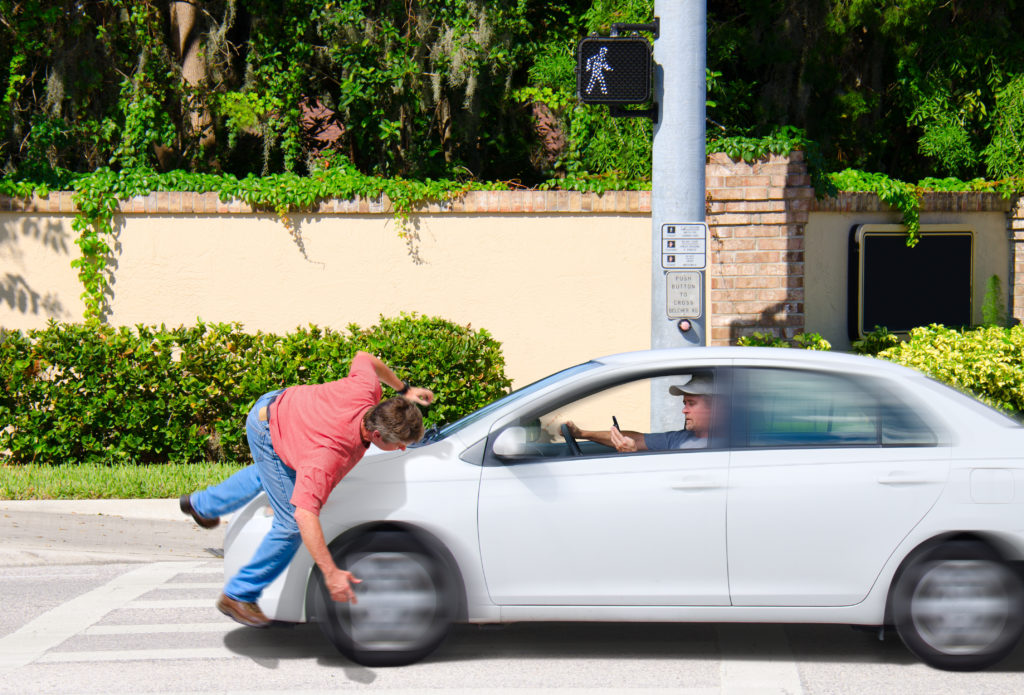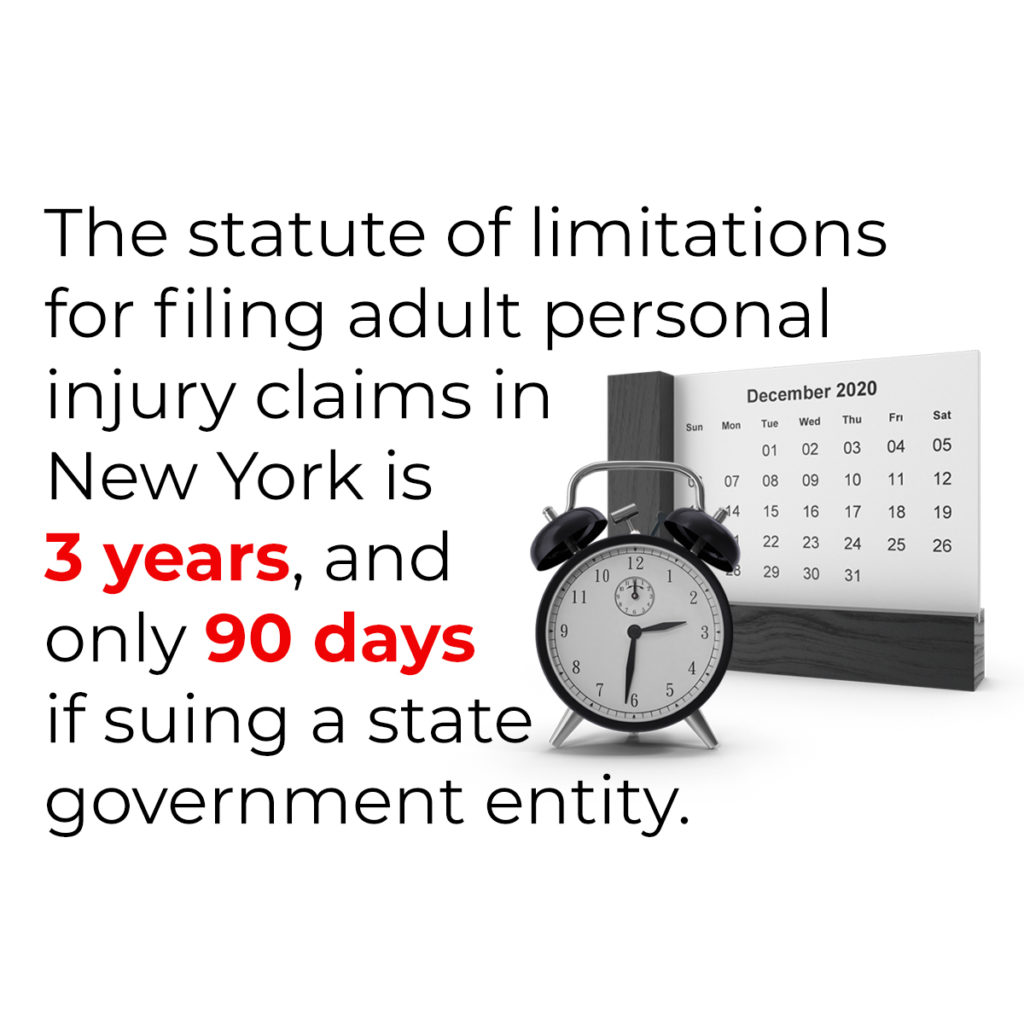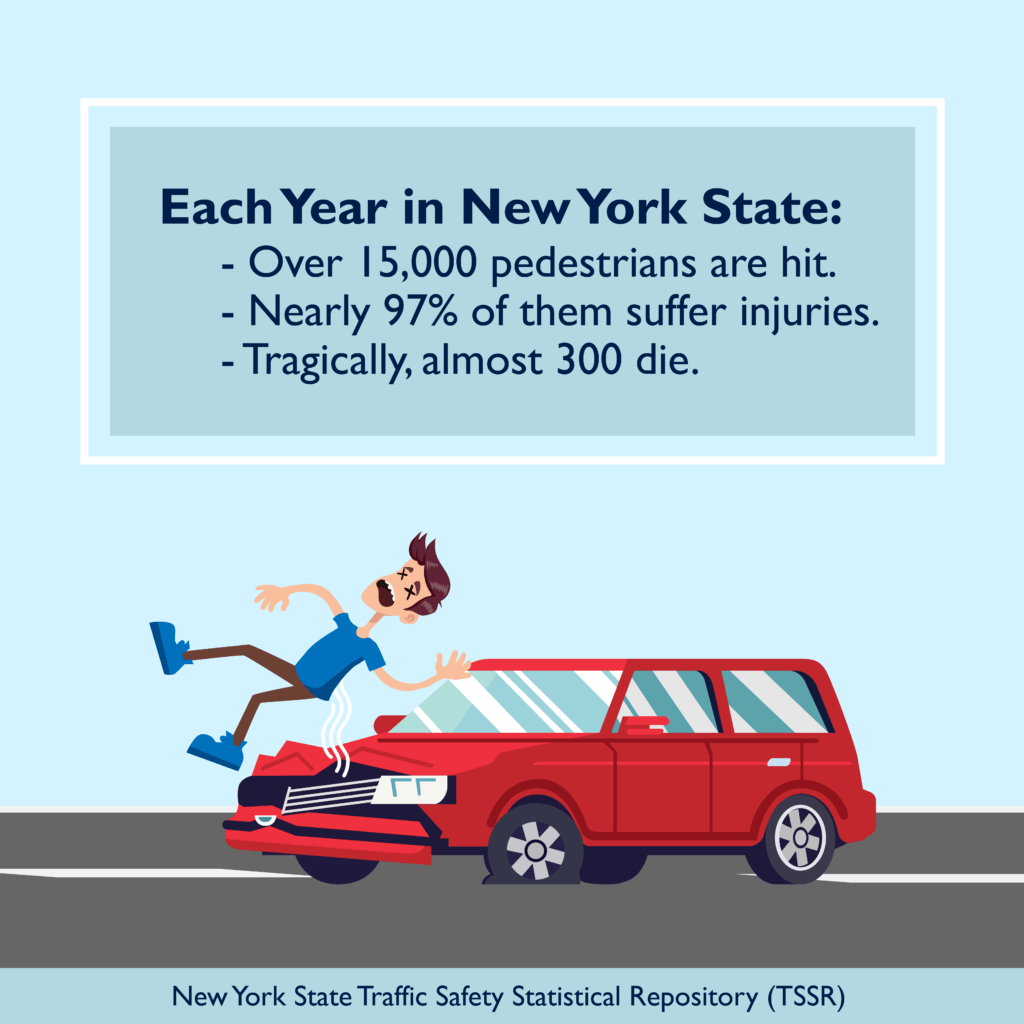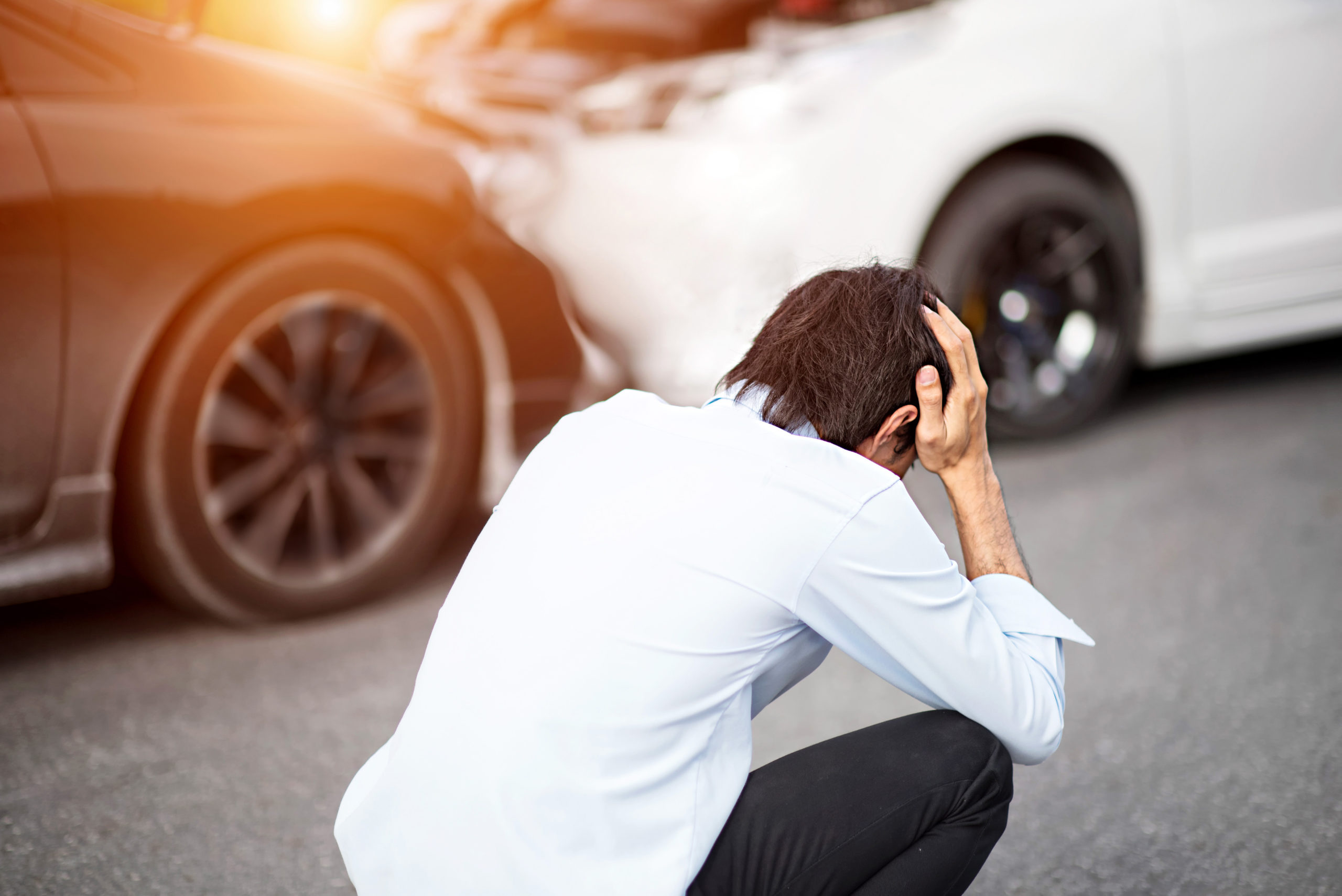
It is well-known that New York’s roadways have seen many unfortunate accidents involving pedestrians, especially in the state’s more densely populated cities. If you or someone you love has been injured as a pedestrian, it is important to understand what forms of compensation one may receive to cover not only medical expenses, but also mental suffering. This article outlines what to consider in these types of accidents so that an attorney can make informed decisions on behalf of the injured pedestrian.
What Are the Causes of Pedestrian-Car Accidents?
Pedestrian-car accidents are oftentimes caused by negligence, usually on the part of the driver. These acts of negligence may include ignoring rules and regulations governing the state’s roadways. For example, a driver may ignore a red light or simply fail to give the right of way to a pedestrian. Other causes include distracted drivers (and/or pedestrians) who may be texting on cell phones, speeding, people driving under the influence of alcohol or drugs, and poor visibility (driving at night or in bad weather).
These accidents may occur on any sort of roadway, but there are certain areas where pedestrians are more susceptible to being struck by a vehicle. A pedestrian is most likely to be struck when crossing a street outside of a designated crosswalk, but they may also be injured when using a designated crosswalk if a driver is distracted. Additionally, parking lots, where pedestrians may not be seen before a vehicle begins to back up, tend to be a location where high rates of car-pedestrian accidents happen. A driver may also lose control of their vehicle and jump a curb, hitting a pedestrian on a sidewalk.
What’s Expected of Drivers and Pedestrians?
Under New York law, both drivers and pedestrians have responsibilities. An experienced personal injury lawyer will investigate to determine who is at fault in an accident. Generally speaking, drivers must always stop for pedestrians at crosswalks, corners, and any other areas marked for pedestrians. They also need to stop and look both ways before making turns.
Pedestrians are expected to look both ways before crossing a street, use designated crosswalks, and step off the curb only when crosswalk lights indicate that it’s safe for them to do so. When someone walks into or crosses a street that has traffic, other than at a marked crosswalk, or otherwise disregards traffic rules, they are known as jaywalkers.
What New York Laws Affect Pedestrians and Their Claims?
New York’s statutes affecting pedestrians, their rights, and their duties are covered primarily in Article 27 of Title 7 in New York’s Vehicle and Traffic Laws.
- NY Veh & Traf L § 1150: This statute states that pedestrians shall follow all traffic control signals listed in NY Veh & Traf L § 1111. However, if there are no such signals available, then pedestrians will have privileges and restrictions stated in the rest of Article 27.
- NY Veh & Traf L § 1151: When no traffic control signals are properly in place, a driver must yield the right of way to a crossing pedestrian using a crosswalk, slowing or stopping if need be. In all situations, a pedestrian shall not abruptly step into a roadway and into the path of a vehicle which will not be able to yield. Whenever a vehicle is stopped at a crosswalk or intersection to permit a pedestrian’s crossing, other vehicles approaching from behind cannot overtake the first vehicle.
- NY Veh & Traf L § 1151-A: A driver emerging from or entering an alleyway, building, private road, or driveway by crossing a sidewalk must yield the right of way.
- NY Veh & Traf L § 1152: If a pedestrian crosses a roadway at any point not designated for use by pedestrians, they must yield the right of way. If they cross a road without using a provided pedestrian tunnel or overhead crossing, they must yield the right of way. Finally, unless following the explicit instructions of a traffic control device, a pedestrian must not cross a roadway intersection diagonally.
- NY Veh & Traf L § 1153: Drivers must yield right of way to pedestrians who have guide dogs or are using a cane which is metallic, white, or white with a red tip. Pedestrians who are not blind cannot use such canes on streets or highways. This is to protect the visually impaired, though they are not required to use any of these tools.
- NY Veh & Traf L § 1155: Pedestrians should always attempt to use the right half of crosswalks when safe to do so. This is to provide additional space between them and oncoming drivers, giving drivers further warning of their presence and pedestrians more room to maneuver if need be.
- NY Veh & Traf L § 1156: Unless it is impossible to use them, a pedestrian must use sidewalks rather than walking along and upon an adjacent roadway. If a sidewalk is not available, pedestrians must walk on the left side of the highway facing traffic and move as far to the left as is safe.
- NY Veh & Traf L § 1157: No one is allowed to stand in a roadway to solicit rides or to solicit or sell to passengers of a vehicle.
Who Has Right of Way in a Parking Lot?
It’s not at all uncommon for people to be hit by cars in parking lots and garages, especially during busy shopping seasons. Oftentimes, pedestrians are struck by vehicles backing out of spaces or entering into the parking lot, their vision blocked by other vehicles. However, the law does not explicitly state who has the right of way in parking lots.
In the case of parking lots that lack designated sidewalks, drivers should expect to yield the right of way to pedestrians. However, a pedestrian must be prepared to announce their presence to drivers and avoid abruptly stepping behind vehicles that may back up in a moment. Pedestrians should also attempt to move at a suitable pace and not block the path of vehicles needlessly.
If there are designated sidewalks and crosswalks, a pedestrian should attempt to make use of them at all times. If they must stop using them in order to approach their vehicle, they should remember the expectations placed upon them in situations where there are no traffic control devices.
After the Accident: What Should You Do?
If you are not seriously injured and are physically able, there are some things you will want to do at the accident scene if you are hit by a car. Understandably, you will be shaken but try to remain as calm and focused as possible.
- Call for help (police, ambulance). The police will write up a report on the accident.
- If you have a cell phone (or happen to have a camera), take pictures.
- Your memory of the accident may fade over time so jot down notes, recording things like where the accident occurred, date and time, driver’s name, and license plate number of the vehicle involved.
- Look for eyewitnesses. If you find any, get their name and contact information.
- Seek medical attention. Even if you don’t need an ambulance, you should see a doctor as soon as possible. You will want to have medical documentation of your injuries.
- Reach out to an experienced law firm. A personal injury attorney will gather other evidence (like security camera footage from nearby buildings), interview any eyewitnesses, and help to establish fault for the accident.
Note that the statute of limitations for personal injury claims in New York is three years from the date of your accident. If you wait any longer than three years, you will most likely be unable to pursue legal action against the party responsible.

Can I Sue After a Pedestrian-Car Accident?
Unfortunately, not all cases of personal injury resulting from pedestrian-car accidents can have a lawsuit brought against the liable party. As a no-fault state, New York requires that an auto accident meet certain requirements before a lawsuit may be made to seek compensation if the pedestrian victim is covered by a New York auto insurance policy. These requirements, known as the serious injuries threshold, are that the injuries cause either economic losses exceeding $50,000 dollars or are of such a serious nature that they invoke unacceptable non-economic loss, such as pain and suffering.
Under New York law, the threshold is met when any of the following injuries occurs in an accident:
- Death
- Dismemberment
- Significant disfigurement
- Bone fracture
- Loss of a fetus
- Permanent loss of use of a body organ, member, function, or system
- Permanent consequential limitation of use of a body organ or member
- Significant limitation of use of a body function or member
- A medically determined injury or impairment of a non-permanent nature which prevents the injured party from performing substantially all of the material acts which constitute their usual and customary daily activities for at least 90 days of the first 180 days after the accident.
When considering if you can or should sue, take the time to speak with an attorney. They will be able to help you analyze your medical expenses, lost wages, and other expenses to know if the accident caused damages exceeding $50,000. Even if the accident did not, an attorney experienced in personal injury cases will be able to know if your injuries are serious enough to warrant a lawsuit for non-economic losses.
Of particular note are lawsuits brought against the state or local public entities. While a public official or entity can be sued for personal injuries, they may be protected by law from liability due to certain considerations provided to them.
In Leonard v. City of New York, for example, a supposedly faulty traffic control device caused a pedestrian-car accident, for which the plaintiff sued the City of New York. The City of New York successfully argued that because it had not been given reasonable notice of a faulty device before the accident, it could not be held as liable for the device’s malfunction, as it did not have time to adequately repair it. Therefore, the plaintiff could not receive compensation from them for the accident.
Proving Who Is at Fault/Negligent
Under New York’s pure comparative fault model, a pedestrian must prove the fault of a driver in order to receive compensation for their injuries. This fault, also known as liability, will be weighed against the pedestrian’s own to determine the exact amount that a plaintiff will receive for their injuries, usually a percentage of the original total cost that they sought. Many factors regarding negligence and reckless behavior on the part of a driver will contribute to their liability in such a case.
One key factor to consider is if the driver was violating New York law when the accident occurred. If a driver violates a New York law governing driving behavior, then they will be ticketed and face penalties that can include fines, imprisonments, and/or points that vary in value depending on severity of the offense.
For pedestrians who are injured in a car accident, the most important violation to consider is if the driver failed to yield the right of way. A driver who fails to yield to a pedestrian will face fines of up to $150 for the first offense, $300 for the second offense, and $450 for the third offense occurring within an 18-month period. If such a violation occurs and leads to an accident, a pedestrian can use the ticket as evidence of liability in their personal injury lawsuit.
However, just like drivers, pedestrians can be at fault in an accident. For example, they may be distracted (by texting) or under the influence of drugs or alcohol. A pedestrian found to be partially liable for the accident and their injuries by extension will have their compensation reduced.
During a trial, a pedestrian plaintiff and a driving defendant will have to argue their cases before a judge and jury to determine liability for the accident. It is a good idea to hire an attorney that is experienced in presenting personal injury cases before the court. They will be able to make the strongest arguments for the liability of the defendant, thereby ensuring you a greater amount of compensation.

Case Study: $3.9 Million
What makes this case unique:Competing arguments on whether the victim had experienced “impending doom”; a big-shot attorney who was “too large” for the case.
Hit-and-Run Car Accidents
Proving fault and knowing what insurance company to pursue for a settlement is a complicated matter in hit-and-run accidents. It is illegal for drivers to leave the scene of an accident and fail to report the accident to police. The table below lists the charges and punishments for these accidents in ascending order of the severity of injuries.
| Level of Injury | Criminal Charge | Fine | Imprisonment |
| Mild to Moderate | Misdemeanor | $250-$1,000 | 90 days to 1 year |
| Serious Injury | Class E Felony | $1,000-$5,000 | Up to 4 years |
| Fatality | Class D Felony | $2,000-$5,000 | Up to 7 years |
You would think that these potential penalties would be enough to discourage drivers from fleeing a crash, but it does happen.
First, you want to try and track down the person driving. This is where a personal injury lawyer can assist by finding and reviewing security video footage and speaking to potential witnesses. Second, you will need to establish fault without the benefit of things like photos of the car’s location and damage immediately after the accident, and the state of the driver. An attorney may be able to trace the whereabouts of the driver immediately before the crash, which can prove valuable if, for example, the driver spent two hours at a bar beforehand.
It’s unfortunate, but sometimes a hit-and-run driver is never located. There will be no defendant and no insurance company to pursue for compensation. In these cases, a lawyer can help identify alternate sources of coverage. Most likely, a claim will need to be filed with the pedestrian’s own insurance company.
What If Someone You Love Is Struck and Killed by a Car?
Sadly, pedestrian-car accidents can often result in death. In 2019 (the most recent year this data is available), the New York State Traffic Safety Statistical Repository (TSSR) recorded 283 pedestrian deaths in the state. While relatively rare compared to the over 15,000 pedestrian accidents that occur, it is important to consider as a real possibility and you need to be prepared for such an event.

An at-fault driver who causes the death of a pedestrian after a car accident may face a wrongful death lawsuit. Just as you need to prove your case in non-fatal accidents, this kind of claim will also need to establish the driver’s negligence in causing the accident. An attorney will gather the evidence needed to get a settlement for family members of the deceased. Among the things that can be compensated for include funeral expenses, wages the deceased would have earned, and lost companionship. The goal of an experienced lawyer is to attain financial security for the victim’s surviving loved ones.
Settling Claims
An experienced lawyer will help you weigh the pros and cons of accepting an insurance settlement amount versus going to trial. How long would it take to litigate and how much would it cost in legal fees? What are the chances you will even win in court?
In practice, most pedestrian car accident claims are settled through the driver’s car insurance, typically by way of an out-of-court settlement. New York requires all drivers to carry car insurance to make sure victims can be compensated. Moreover, all New York car insurance policies must include coverage for first party benefits, sometimes called personal injury protection (PIP) benefits or medical expense benefits (MEB) to cover medical bills. If multiple cars are involved in the accident, a pedestrian may be able to get settlements from more than one defendant and insurer.
What if the driver who injured a pedestrian did not comply with New Jersey law and was uninsured at the time of the accident? As in the case of hit-and-run crashes, it’s likely your attorney will need to pursue a claim with your own insurance company, and your insurer will generally file a claim against the driver for their expenses covering your compensation.
Settlement Amounts
The first party benefits of your auto insurance policy only cover what the law calls economic damages such as medical bills and wages lost because the injured person cannot work. They do not cover pain and suffering, loss of enjoyment of life, or other, non-economic types of damage. Moreover, first party benefits have policy limits with the legal coverage maximum being only $50,000 to cover basic economic losses.
You will want an experienced personal injury lawyer working on your behalf if any of the following occur:
- Your insurance denies these first party benefits.
- Your medical costs exceed the first party policy limit and thus you must sue a liable party.
- You want to recover the less quantifiable (non-economic) damages from the party at fault.
Compensation for economic losses will be limited to paying only for amounts in excess of the first party policy limits. Compensation for non-economic losses, on the other hand, can vary wildly in comparison due to requiring the subjective analysis of a judge and jury to determine. As such, it is important that you understand the average settlement amounts for car accidents.
Settlements are binding legal agreements, and accepting a settlement forfeits the right to sue. If the settlement turns out not to be enough, there is no way to get more compensation. A lawyer can evaluate the settlement and circumstances of the accident to make sure that the injured person is getting all the money they deserve. The same applies to loved ones of a pedestrian who dies in such an accident.
When it comes to considering fault in pedestrian-car accidents, it’s important to remember that the driver is not always 100% responsible. New York requires pedestrians to follow the right-of-way laws. If the pedestrian is at least partially to blame for the accident (by darting out into the road outside of a crosswalk, distracted by texting, or impaired by drugs or alcohol, for example), insurance companies will lower the award offered. If the settlement was calculated to be $100,000, but it was determined that the pedestrian was 30% responsible for the accident, the final amount will be reduced to $70,000.
Generally, the more severe the injuries, the more a pedestrian can expect to be compensated through insurance company settlements.
Statistics for Pedestrian Accidents in New York
Most pedestrian car accidents in New York are not fatal but that doesn’t mean that injuries caused by them aren’t serious. Yes; some lucky people may sustain only cuts and bruises if struck by a car barely moving. Unfortunately, a person hit by a vehicle can also suffer moderate or significant injuries, perhaps even permanent and life-altering ones. Common pedestrian injuries include:
- Bone fractures
- Brain injuries
- Spinal cord injuries
- Disfiguring lacerations
- Loss of a limb
- Organ damage
The table below shows the most recent data available from the TSSR for pedestrian crashes, injuries, and fatalities.
Pedestrian Crashes, Injuries, and Fatalities in NY, 2015 – 2019
| Year | Pedestrian Crashes | Pedestrian Injuries | Pedestrian Fatalities |
| 2015 | 13,225 | 12,873 | 316 |
| 2016 | 15,084 | 14,723 | 316 |
| 2017 | 15,239 | 14,912 | 249 |
| 2018 | 15,566 | 15,147 | 269 |
| 2019 | 15,451 | 14,981 | 283 |
As the numbers would suggest, it is incredibly common for pedestrians to be injured when involved in a traffic accident. When a driver hits a pedestrian, it is almost always the pedestrian who bears the brunt of the collision due to having little in the way of protection.
Going to Trial
Most pedestrian car accident claims are settled before going to trial. If an agreement cannot be reached, a case will go to trial. This process will take longer and likely cost more money to pursue. You will want to consult with an experienced personal injury attorney to weigh your options. Together, you can discuss the chances of winning, and if the amount likely awarded will offset the extra time and money it took to go to court. If you do proceed to trial, your lawyer will be prepared to present your case to a jury.
Frequently Asked Questions
Yes, if the costs of economic damages exceed the $50,000 provided by first party benefits or if your injuries fall under the legal distinction of serious injuries. If they do not, then you will not be able to sue.
Although drivers in New York are required to carry insurance, not everyone obeys the law. In these situations, a lawyer will most likely pursue a claim with the pedestrian’s own insurance company. Additionally, auto insurance policies may also include uninsured and underinsured motorist coverage for situations such as these
The amount will vary based on the severity of injuries and degree of fault in the accident. Settlements should cover medical expenses, lost wages, and maybe even non-economic damages (pain and suffering).
Drivers are required by law to yield for pedestrians but New York assigns responsibilities to pedestrians as well. The driver may be 100% in the wrong, or both driver and pedestrian can have some fault. An experienced personal injury lawyer will help to establish which party is to blame, and to what extent.
In New York, a driver who hits a pedestrian will get points on his/her license (or have it suspended) and may face fines and/or imprisonment. If the pedestrian is killed and the driver was drunk at the time of the accident, a charge of vehicular manslaughter and jail time are likely.
Who Should I Contact About My Pedestrian Accident Injuries?
If you or someone you love has been injured or killed in a pedestrian accident, contact the attorneys at Rosenblum Law. Our experienced and skilled attorneys have won many cases with positive results. To speak directly to one of our attorneys, call 888-235-9021 or email us today.


